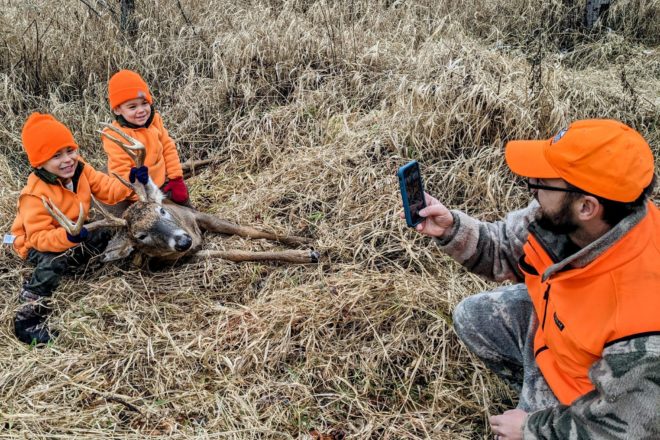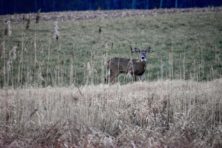Wild Things: Deer Harvest Both Up and Down This Season
- Share
- Tweet
- Pin
- Share

Numbers will only rise with muzzleloader up and antlerless-only season on deck
by KEVIN NAZE, [email protected], Peninsula Pulse contributor
Door and Kewaunee County deer hunters combined to register 4,179 whitetails during the nine-day gun season that ended Nov. 27 – up slightly from last year, but about 450 fewer than the five-year average. Combined with the early bow, crossbow and youth gun season totals, hunters have registered about 6,000 deer so far on the Kewaunee/Door peninsula.
That number will continue to climb. The 10-day muzzleloader hunt ends Dec. 7, but it’s immediately followed by a four-day, antlerless-only gun deer hunt. After that, it’s back to camouflage for bow and crossbow hunters before nine more days of blaze during a holiday antlerless gun deer season Dec. 24 – Jan. 1.
At a virtual media briefing Tuesday morning, Jeff Pritzl, a deer program specialist with the Department of Natural Resources, said the preliminary nine-day totals statewide were 203,295 deer taken, including 98,397 antlered bucks. He expected the numbers to rise by a thousand or two as additional registrations trickle in from those who did not register by 5 pm on Nov. 28.
Statewide, the total harvest was up 14.4% over last year and 7.7% over the five-year average. The biggest increases were in the Northern and Central Forest zones.
Locally, Door County hunters registered 1,131 antlered bucks and 1,260 antlerless, for 2,391 total. That’s up 4.5% over 2021, but down 6.8% from the five-year average.
Kewaunee County hunters registered 729 bucks and 1,059 antlerless for a total of 1,788 – down 1.9% from last year and 13.4% below the five-year average.
Combined with the bow, crossbow, youth hunt and deer taken on damage permits, Door was up to 3,424 (1,690 bucks) through Nov. 28, while Kewaunee had 2,549 (1,155 bucks).
Door County’s deer harvest has surpassed 4,000 in eight of the past 15 years, including a record 5,264 in 2017. Last year, only 3,940 were registered by hunters – the least since 2014. About 90% of the deer are taken on private land.
Thought to be the true barometer of a deer population, the buck kill has topped 2,000 in Door County only twice. The record of 2,064 came in 2017. Compare that to just 73 bucks registered in Door County in 1960. A decade later, there were 325. In 1980, 444; in 1990, 1,289; in 2000, 1,694; in 2010, 1,390; and in 2020, 1,704.
Kewaunee County’s record season was also 2017, with 3,787 deer registered. That county’s buck-kill record came in 2015 – the first year of electronic registration for all – at 1,589. It has slid since, down to 1,235 last year. However, that’s still more than any year prior to 2012.
When looked at in terms of deer taken per square mile of deer habitat (forests, marshes and other large tracts of cover), Pritzl said Kewaunee County was third in the state, at 14.5 deer killed per square mile of deer range during the gun hunt.
In 1960, only 52 bucks were registered in the county. There were 190 reported in 1970, 413 in 1980, 686 in 1990, 889 in 2000, 830 in 2010 and 1,319 in 2020.
Eight Shooting Incidents during Nine-Day Hunt
April Dombrowski, chief of the Department of Natural Resources’ Recreational Safety Section, said there were eight shooting incidents during the nine-day hunt, including one fatality. Six, including the fatality, occurred during opening weekend.
Four injuries – three bullets to the feet or leg involving long guns, and one a bullet to a finger involving a handgun – were accidentally self-inflicted.
Three other incidents, including the fatality, involved members of the same party. The fatality happened while a hunter was unloading a firearm in the back seat of a vehicle. The other same-party incidents took place during a deer drive, and in a ground-blind-to-ground-blind shooting.
Just one incident involved two different parties. It took place during a deer drive on public land in Jefferson County when one of the drive participants shot at a running deer and hit a hunter – who was on adjacent private land sitting in a ground blind – in the thigh.
Overall, Dombrowski said, hunting is a safe activity in Wisconsin. The past 10 gun seasons have seen an average of 6.4 incidents per year, or about one per 90,000 participants.
Still, she reminded hunters to heed the rules of firearm safety, especially controlling the muzzle.
“Load the mind before loading the gun,” she said.
License Sales Down
Through Nov. 27, there were 554,838 licenses allowing gun deer hunting sold (Gun Deer, Sports and Conservation Patron). That was down 1.69% from 2021, and about 140,000 fewer gun hunters than there were at the turn of the century.
“It’s mostly tied to just the demographics of the hunting population, and this is a phenomenon that’s been going on across the country,” Pritzl said. “As the baby boomer generation is aging out of deer hunting, they’re not being replaced at the same rate that they’re leaving.”
The growth of crossbow hunting has offset some of the gun-sales losses. Including bow and crossbow license sales, the combined total of license sales stood at more than 795,000 – down 1.6% from last year’s 808,000 during the same time period.
Despite the decline, Eric Lobner, director of the Department of Natural Resources’ Wildlife Management Bureau, said hunting is about a $2 billion industry in Wisconsin.




